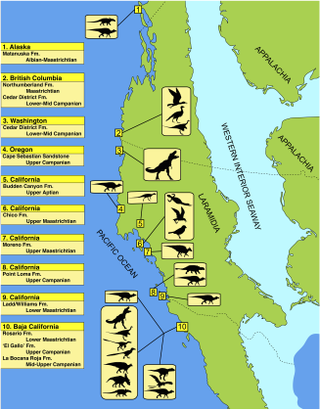
The Cloverly Formation is a geological formation of Early and Late Cretaceous age that is present in parts of Montana, Wyoming, Colorado and Utah in the western United States. It was named for a post office on the eastern side of the Bighorn Basin in Wyoming by N.H. Darton in 1904. The sedimentary rocks of formation were deposited in floodplain environments and contain vertebrate fossils, including a diverse assemblage of dinosaur remains. In 1973, the Cloverly Formation Site was designated as a National Natural Landmark by the National Park Service.

The Lameta Formation, also known as the Infratrappean Beds, is a sedimentary geological formation found in Madhya Pradesh, Gujarat, Maharashtra, Telangana, and Andhra Pradesh, India, associated with the Deccan Traps. It is of the Maastrichtian age, and is notable for its dinosaur fossils.

The Arundel Formation, also known as the Arundel Clay, is a clay-rich sedimentary rock formation, within the Potomac Group, found in Maryland of the United States of America. It dates to the Early Cretaceous, and is of late Aptian or early Albian age. This rock unit had been economically important as a source of iron ore, but is now more notable for its dinosaur fossils. It is named for Anne Arundel County, Maryland.
The Milk River Formation is a sandstone-dominated stratigraphic unit of the Western Canada Sedimentary Basin in southern Alberta, Canada. It was deposited in near-shore to coastal environments during Late Cretaceous time. Based on uranium-lead dating, palynology and stratigraphic relationships, deposition occurred between ~84.1 and 83.6 Ma.
The Claggett Shale is a geological formation in Montana whose strata date back to the Late Cretaceous. Dinosaur remains are among the fossils that have been recovered from the formation.

The Almond Formation is a geological formation of Late Cretaceous age in Wyoming. It was deposited in marsh, deltaic, lagoonal, estuarine, and shallow marine environments along the western shore of the Western Interior Seaway. It consists primarily of fine- to medium-grained sandstone, siltstone, shale, and coal. Fossils from the Almond Formation include remains of dinosaurs and plants.
The Ferris Formation is a Late Cretaceous to Paleocene, fluvial-deltaic geological formation in southern Wyoming. It contains a variety of trace and body fossils, preserved in sandy fluvial channel deposits and overbank units. Dinosaur remains are fragmentary, but include Triceratops, Tyrannosaurus, dromaeosaurids, Paronychodon, Ricardoestesia, Edmontosaurus, Edmontonia, Ankylosaurus, and Pachycephalosaurus.
The Mooreville Chalk is a geological formation in North America, within the U.S. states of Alabama and Mississippi, which were part of the subcontinent of Appalachia. The strata date back to the early Santonian to the early Campanian stage of the Late Cretaceous. The chalk was formed by pelagic sediments deposited along the eastern edge of the Mississippi embayment. It is a unit of the Selma Group and consists of the upper Arcola Limestone Member and an unnamed lower member. Dinosaur, mosasaur, and primitive bird remains are among the fossils that have been recovered from the Mooreville Chalk Formation.
The Glauconie argileuse is a geological formation in Europe whose strata date back to the Late Cretaceous. Dinosaur remains are among the fossils that have been recovered from the formation.
The Bostobe Formation is a geological formation in Qaraghandy & Qyzylorda, Kazakhastan whose strata date back to the Late Cretaceous.
The Minhe Formation is a geological formation in northwestern China, whose strata date back to the Late Cretaceous period.
The Yuliangze Formation, or Yuliangzi Formation, is a geological formation in Heilongjiang, China whose strata date back to the early-middle Maastrichtian. Dinosaur remains are among the fossils that have been recovered from the formation.

The Ripley Formation is a geological formation in North America found in the U.S. states of Alabama, Georgia, Mississippi, Missouri, and Tennessee. The lithology is consistent throughout the layer. It consists mainly of glauconitic sandstone. It was formed by sediments deposited during the Maastrichtian stage of the Late Cretaceous. It is a unit of the Selma Group and consists of the Cusseta Sand Member, McNairy Sand Member and an unnamed lower member. It has not been extensively studied by vertebrate paleontologists, due to a lack of accessible exposures. However, fossils have been unearthed including crocodile, hadrosaur, nodosaur, tyrannosaur, ornithomimid, dromaeosaur, and mosasaur remains have been recovered from the Ripley Formation.

The Cape Sebastian Sandstone is a Mesozoic geologic formation in the state of Oregon in the United States. Hadrosaurid dinosaur remains, such as the sacrum of the Cape Sebastian ornithopod, are among the fossils that have been recovered from the formation, although none have yet been referred to a specific genus. The formation dates to the Campanian stage of the Late Cretaceous epoch.
The Futaba Group is a Late Cretaceous geologic group in Japan. Dinosaur remains are among the fossils that have been recovered from the formation, although none have yet been referred to a specific genus. It consists of both fluvial and shallow marine sediments. The plesiosaur Futabasaurus was found in this unit.
The Iljig Formation is a Lower Cretaceous geologic formation in South Korea. Dinosaur remains are among the fossils that have been recovered from the formation, although none have yet been referred to a specific genus.

The Meeteetse Formation is a Late Cretaceous geologic formation occurring in Wyoming.
The Sangarskaya Svita is an Early Cretaceous geologic formation in Russia. Dinosaur remains from the Ankylosauridae are among the fossils that have been recovered from the formation, although none have yet been referred to a specific genus.
The Korycanar Formation is a Late Cretaceous geologic formation in the Czech Republic. Archosauromorph remains diagnostic to the genus level are among the fossils that have been recovered from the formation and also dinosaur remains are among the fossils that have been recovered from the formation, although none have yet been referred to a specific genus.
The Ialovachsk or Yalovach Formation is a geologic formation in Kyrgyzstan, Tajikistan and Uzbekistan dating to the Santonian age of the Cretaceous period.






